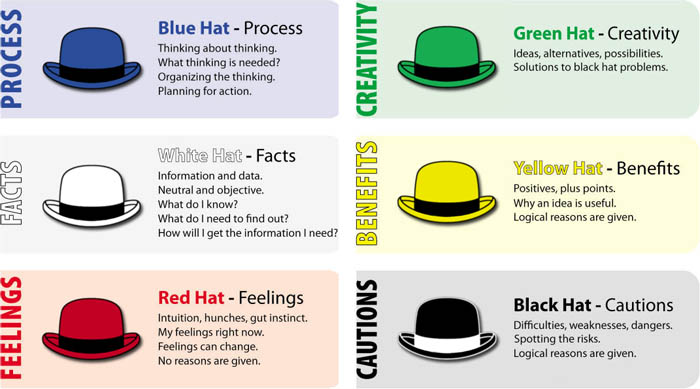An excellent tool for decision-making, problem solving, new idea generation, or effective meetings is The Six Thinking Hats (Hats). Developed by Dr. Edward de Bono, the Hats are the cornerstone of de Bono’s parallel thinking theory: separate thinking to ensure participants work in parallel (together) to achieve the optimal solution.
The Six Thinking Hats
The Hats are imaginary “thinking hats” that strive to separate thinking to avoid argument and develop issues more thoroughly. Each hat represents a specific thinking role, ensuring participants focus on one role at a time. The following is each hat’s focus.
Blue hat — facilitator
White hat — data and information
Red hat — emotions, feelings, intuition
Yellow hat — benefits, values, feasibility
Black hat — concerns, cautions, problems
Green hat — creative ideas, alternatives, possibilities
Parallel thinking and the Hats are designed to ensure each area of focus for a topic or problem is discussed individually, then the group moves to the next area of focus until the topic is analyzed thoroughly. For example, the group only discusses the white hat, what data and information is available, and then move to the red hat, only discussing emotions or feelings. The group does not jump back-and-forth between different hats. The group stays on one hat, and then moves on; leveraging focus and discipline.
The Black Hat
The black hat is the driver for critical thinking within the Hats. The black hat is not negative. It is about ensuring a topic or problem is properly dissected. As any critical thinker knows, it is essential to dissect the evidence and recommendations of arguments to ensure nothing is missed and the best idea is developed. Too often, someone brings up an idea and the resident “dark cloud” immediately starts picking it apart. This is often why the black hat gets a bad rap as being the negative hat, it’s not.
I see this too often with those who use critical thinking without tact. Most decisions are based on emotions and supported with biases and assumptions. When using critical thinking to analyze an idea or decision, it is recommended to let the group know a specific time for critical analysis is needed. Let the group know, “it’s time for some black hat thinking”. Then, the group is ready for questions and dissection of the argument to ensure it is based on strong evidence to proceed. This method will reduce any tension or defensiveness.
You should also initiate black hat thinking when presenting your own ideas. Encourage the team to conduct some “black hat thinking” on your proposal. This will demonstrate to the group the need for critical thinking, especially with your own ideas. This activity will demonstrate to team members that everyone’s ideas must be critically analyzed – our own and other team members. In relation to creative thinking, the black hat is a vital part of green hat ideas.
Creative thinking and critical thinking work in tandem. Creative thinking (green hat) is used to expand, move forward, and focus on the generation of ideas; divergent thinking. Critical thinking (black hat) comes into play to narrow the list of ideas and determine those with the highest probability of success; convergent thinking. Unfortunately, too often people feel black hat activities focus on “killing” good ideas and being negative. What the black hat is designed to do is analyze and question ideas, decisions, or solutions. The black hat is crucial to ensuring nothing is missed or identify potential problems not previously noted.
Conclusion
The strength of the Hats is forcing team members to analyze a topic holistically. Those who are against the idea, must come up with positive aspects (yellow hat), while those who love the idea must identify possible problems or concerns (black hat). The power of the black hat is to impart skepticism and a reality check (and devil’s advocate) into the discussion in a positive way. Practicing critical thinking skills as black hat exercises develops a team’s capacity to accept questioning and analysis of all ideas for the betterment of the organization.





